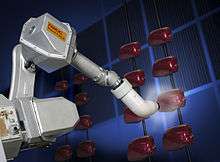Automotive paint

Automotive paint is paint used on automobiles for both protection and decoration purposes.[1][2] The paint layers total to around 100 µm.
Characterization
Modern automobile paint is applied in several layers, with a total thickness of around 100 µm(0.1mm).
History
In the early days of the automobile industry, paint was applied manually and dried for weeks at room temperature. As mass production of cars started, paint was dried in ovens. Nowadays, paint is usually applied by robotic arms and dried in just a few hours.
Environmental laws
Until several decades ago lead, chromium and other heavy metals were used in automotive paint. Environmental laws have prohibited this, which has resulted in a move to water-based paints. Up to 85% of lacquer paint can evaporate into the air, polluting the atmosphere. Enamel paint is better for the environment in that regard, and has become the most widely used paint nowadays.[1]
Processes and coatings
Preparation
High pressure water spray jets are directed to the body. Without proper pretreatment, premature failure of the finish system can almost be guaranteed.
A phosphate coat is necessary to protect the body against corrosion effects and prepares the surface for the E-Coat.
The body is dipped into the Electro Coat Paint Operation (ELPO/E-Coat), then a high voltage is applied. The body works as a cathode and the paint as an anode sticking on the body surface. It is an eco-friendly painting process. In E-Coat, also called CED paint, utilisation is approximately 99.9% and has great SST life compared to other painting processes.
Primer
The primer is the first coat to be applied. The main functions of the primer are to act as a leveler and protector, and to make the base coat easier to apply to the component to which it is applied. The primer serves several purposes. It serves as a leveler, which is important since the cab often has marks and other forms of surface defect after being manufactured in the body shop. A smoother surface is created by leveling out these defects and therefore a better final product. It serves as a protector, the primer will protect from corrosion, heat differences, bumps, stone-chips, UV-light, etc. It also improves ease of application by making it easier for paints to stick to the surface, a more varied range of paints can be used.
Basecoat
The base coat is applied after the primer coat. This coat contains the visual properties of color and effects, and is usually the one referred to as the paint. Base coat used in automotive applications is commonly divided into three categories: solid, metallic, and pearlescent pigments.
- Solid paints have no sparkle effects except the color. This is the easiest type of paint to apply, and the most common type of paint for heavy transportation vehicles, construction equipment and aircraft. It is also widely used on cars, trucks, and motorcycles.
- Metallic paints contain aluminium flakes to create a sparkling and grainy effect, generally referred to as a metallic look. This paint is harder to manage than solid paints because of the extra dimensions to consider. Metallic and pearlescent paints must be applied evenly to ensure a consistent looking finish without light and dark spots which are often called "mottling".
- Pearlescent Paints contain special iridescent pigments commonly referred to as "pearls". Pearl pigments impart a colored sparkle to the finish which works to create depth of color. Pearlescent paints can be two stage in nature (pearl base color + clear) or 3 stage in nature (basecoat + pearl midcoat + clearcoat).[3]
Clearcoat
Usually sprayed on top of a colored basecoat, clearcoat is a glossy and transparent coating that forms the final interface with the environment. For this reason, clearcoat must be durable enough to resist abrasion and chemically stable enough to withstand UV light. Clearcoat can be either solvent or water-borne.[4] One part and two part formulations are often referred to as 1k and 2k respectively.[5]
See also
Automotive Paint Suppliers
- BASF
- Concept Paints http://conceptpaints.com.au/
- PPG Industries
- Axalta
- DuPont
- AkzoNobel
- Valspar
Automotive Paint Equipment Suppliers
References
- 1 2 John Pfanstiehl (1998). Automotive Paint Handbook: Paint Technology for Auto Enthusiasts & Body Shop Professionals. Penguin. ISBN 978-1-55788-291-2.
- ↑ Kimio Toda; Abraham Salazar; Kozo Saito (21 December 2012). Automotive Painting Technology: A Monozukuri-Hitozukuri Perspective. Springer Science & Business Media. ISBN 978-94-007-5095-1.
- ↑ A Guide to Auto Paint Colors
- ↑ DuPont Automotive: Paint & Coatings for Metal Exterior
- ↑ 1K Coating vs 2K Coatings
- ↑ "TKS Industrial". Retrieved 5 January 2016.
- Automotives Paints and Coatings, Streitberger & Dössel, 2008
- Hans-Joachim Streitberger; Karl-Friedrich Dossel (31 March 2008). Automotive Paints and Coatings. John Wiley & Sons. ISBN 978-3-527-30971-9.